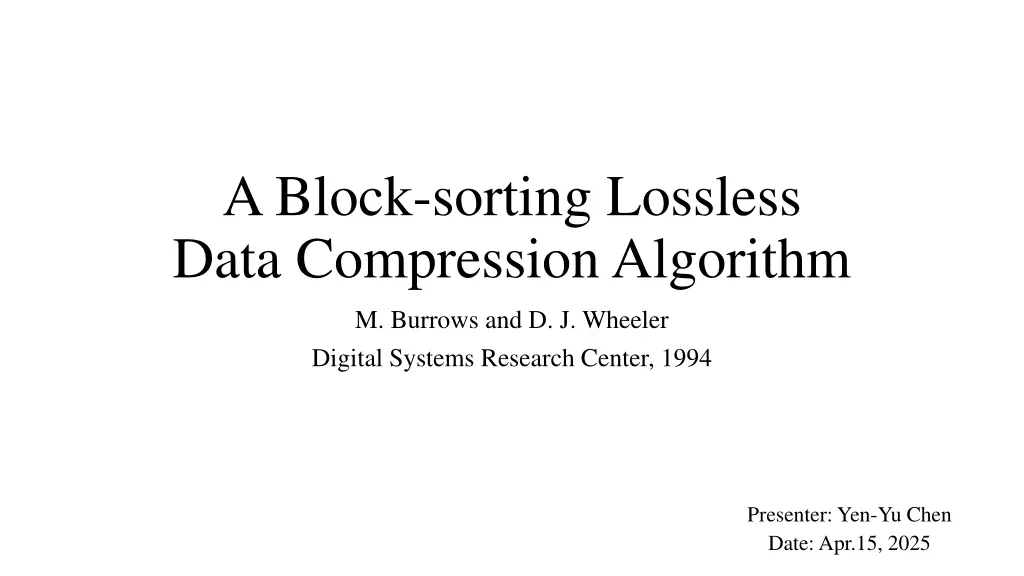
Lossless Data Compression Algorithm Overview
Exploring the block-sorting lossless data compression algorithm by M. Burrows and D. J. Wheeler, including its transformation steps, rotation and sorting techniques, and key properties. The algorithm achieves efficient compression comparable to leading methods while emphasizing simplicity and speed on a block of input text.
Download Presentation

Please find below an Image/Link to download the presentation.
The content on the website is provided AS IS for your information and personal use only. It may not be sold, licensed, or shared on other websites without obtaining consent from the author. If you encounter any issues during the download, it is possible that the publisher has removed the file from their server.
You are allowed to download the files provided on this website for personal or commercial use, subject to the condition that they are used lawfully. All files are the property of their respective owners.
The content on the website is provided AS IS for your information and personal use only. It may not be sold, licensed, or shared on other websites without obtaining consent from the author.
E N D
Presentation Transcript
A Block-sorting Lossless Data Compression Algorithm M. Burrows and D. J. Wheeler Digital Systems Research Center, 1994 Presenter: Yen-Yu Chen Date: Apr.15, 2025
Abstract We describe a block-sorting, lossless data compression algorithm, and our implementation of that algorithm. We compare the performance of our implementation with widely available data compressors running on the same hardware. The algorithm works by applying a reversible transformation to a block of input text. The transformation does not itself compress the data, but reorders it to make it easy to compress with simple algorithms such as move-to-front coding. Our algorithm achieves speed comparable to algorithms based on the techniques of Lempel and Ziv, but obtains compression close to the best statistical modelling techniques. The size of the input block must be large (a few kilobytes) to achieve good compression.
Transformation Step Takes a string S of N characters Generates all N cyclic rotations of S Sorts the rotations in lexicographic order Extracting the last character of each of the rotations Extracts the last character of each sorted rotation to form a new string L Records the index I of the original string S in the sorted list Output is a pair (L,I)
Rotation String S : "abraca" a a c a r b b a a c a r r b a a c a a r b a a c c a r b a a a c a r b a
Sort String S : "abraca" row 0 1 2 3 4 5 F a a a b c r L c a r a a b a b c r a a b r a a a c r a a c b a a c b a r a Output: (L,I) L: caraab I:1 I=
Property Any row and column is permutation of S For any row i, the character L[i] comes immediately before F[i] in the original string S The k-th occurrence of ch in L corresponds to the k-th occurrence of ch in F
Rotation String S : a0,b0,r0,a1,c0,a2 a0 a2 c0 a1 r0 b0 b0 a0 a2 c0 a1 r0 r0 b0 a0 a2 c0 a1 a1 r0 b0 a0 a2 c0 c0 a1 r0 b0 a0 a2 a2 c0 a1 r0 b0 a0
Sort a2 a0 a1 b0 c0 r0 a0 b0 c0 r0 a2 a1 b0 r0 a2 a1 a0 c0 r0 a1 a0 c0 b0 a2 a1 c0 b0 a2 r0 a0 c0 a2 r0 a0 a1 b0
Construct F row 0 1 2 3 4 5 F a a a b c r L c a r a a b a b c r a a b r a a a c r a a c b a a c b a r a
Decode row 0 1 2 3 4 5 F a a a b c r L c a r a a b a b c r a a b r a a a c r a a c b a a c b a r a I=
Why L is Suitable for Compression 100 the in text row he t appear 100 times
Experiment BWT Move-To-Front (MTF) Huffman coding
